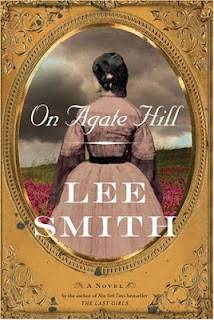On Agate Hill
Summary (from the publisher): Molly Petree, orphaned by the Civil War, is by her ow definition, "a spitfire and a burden. I do not care. My family is a dead family, and this is not my home, for I am a refugee girl."
Raised in the ruins of a once prosperous plantation on Agate Hill in North Carolina, she's a refugee who has no interest in self-pity. To document her headstrong life, she collects its artifacts - her lifelong diaries, letters, poems, songs, newspaper clippings, court records, marbles, rocks dolls, bones (some human, some not).
When a mysterious benefactor appears out of her father's past to rescue her, teenaged Molly Petree never looks back. Taking what she is offered, she saves herself and then risks everything to hold true to her nature and to true love. She casts aside two prosperous, well-born suitors to marry a dashing - and philandering - mountaineer only to be accused of his murder. The end of Molly Petree's story is as unpredictable and as passionate as her own wide-open heart.
Spanning half a century, Lee Smith's portrait of a fiery Southern woman recalls the South from Reconstruction to the Roaring Twenties - and, in the process, gives us Molly Petree, living and breathing, gripping the reader's arm as the story unfolds.
Review: Molly Petree's story reminds me so much of an American, post-Civil war retelling of Jane Eyre. Orphaned by the Civil War, Molly lives in a dysfunctional and unhealthy environment with her elderly uncle and an assortment of servants and relatives. Suddenly, an old friend of her parents' appears on the scene and pays for her to attend boarding school. The headmistress of the Boarding School is not Molly's biggest fan, ultimately leading to her leaving the school after graduation and a brief stint as a teacher. There Molly's life takes an abrupt turn, when she falls for a wild, mountain man, turns down two other more eligible suitors to marry him, tragically loses multiple children, and her husband is mysteriously killed. Molly ultimately returns to a much changed Agate Hill in the conclusion of the novel.
The frame story of this novel is a letter from an errant grad student, writing to her professor that she has found a collection of diary entries and documents detailing Molly's life. The actual novel is told in the form of letters and diary entries. I did enjoy the epistolary nature of this novel, especially since it allows you to see Molly from multiple perspectives. However, it does leave gaps in the narration since Molly does not continually narrate throughout.
It took me a while to get into this novel, but I ended up enjoying it. One of my main frustrations was how characters appear and then leave, never to reappear. For example, Mary White is Molly's best friend as a child but the reader never learns what happens to her after she abruptly leaves Agate Hill. Similarly, the readers gets to read a lot about the headmistress of Gatewood Academy, Mariah Snow, since her diary entries are included, but her past, which clearly was scandalous, is only alluded to and never revealed. I was also frustrated to never learn more about Simon Black, Molly's benefactor. He remained a creepy character throughout, appearing and disappearing without any decent explanation of his strange interest in Molly.
My other main frustration was the 360 in Molly's characterization from childhood to adult. I know her circumstances chanced abruptly, and moving to adulthood changes a person, but it just didn't jive for me. Throughout her childhood, Molly continually references how she doesn't want to have children, and yet her inability to have a healthy child is ultimately what destabilizes her marriage. The wounded, wary child of Agate Hill seems nothing like the social butterfly who winds up living in the mountains, madly in love with her husband.
Stars: 3.5



Comments
Post a Comment